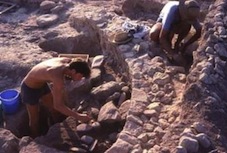
The bath complex is extraordinary in that it was founded in the Hellenistic Period, probably in the 3rd century BCE and continued in use into the Roman Period, certainly into the 1st century CE. A pipe trench was found in which numerous fragments of terracotta pipes were excavated. The large basin had three complete layers of hydraulic cement each laid at a different period. In the trench where the terracotta pipes that carried water to the installations, and in neighboring trenches, many fragments of limestone sculpture and terracotta figurines were found.
In addition to the bath complex, the expedition excavated a temple known as “The Sanctuary of the Paired Deities”. It is dedicated to a pair of gods represented by standing stones. There are numerous altars and sacrificial ash pits in this temple, and this year the Lycoming College team discovered a series of impressive channels constructed to carry water into a kind of grotto in bedrock underlying the Temple structure. The Sanctuary of the Paired Deities at Idalion is unique to Cyprus. Its many altars and religious installations are preserved in situ as they were used from around 1050 BCE until the Roman Period in the 1st century CE.
It is obvious that the place was sacred for a long time as ancient artifacts were found buried reverently in the mud brick debris above the sanctuary, probably in the Middle Ages. That would explain why the site of the Temple remained undisturbed until it was discovered in 1998. These installations relate to the 8th century BCE cuts in bedrock in the Goddess Temple atop the site of Ancient Amathus. Clearly something in the worship of the Great Goddess of Cyprus, who was later known to the Greeks as Aphrodite, related to water flowing into the rock of the Earth.
The third area under investigation during the 2011 season was the Adonis Temenos on the East Acropolis, Mouti tou Arvili. There the Lycoming team discovered that the buildings uncovered in previous seasons, including the one in which a feasting set was found in 2010, date back to the Cypro-Geometric Period, probably to the 9th century BCE. This proves that at least two of the six known temples and sanctuaries at Ancient Idalion were in use for at least 1000 years. The earliest floor was formed on the bedrock itself.
During the 2012 season the Lycoming College Expedition to Idalion intends to continue investigations into the Hellenistic and Roman Baths, the Adonis Temenos, and the Sanctuary of the Paired Deities.
See all the latest news from Greece and the world at Greekreporter.com. Contact our newsroom to report an update or send your story, photos and videos. Follow GR on Google News and subscribe here to our daily email!



